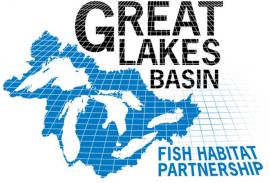
The international Great Lakes Basin is a unique and biologically diverse region containing the largest surface freshwater system in the world, with sport and commercial fisheries valued at over $7 billion annually. The fishery and aquatic resources of the Great Lakes have suffered detrimental effects of invasive species, loss of biodiversity, poor water quality, contaminants, loss or degradation of coastal wetlands, land use changes, and other factors. The Basin includes all of Michigan; portions of New York, Pennsylvania, Ohio, Indiana, Illinois, Wisconsin, and Minnesota in the U.S. and Ontario and Quebec in Canada. It covers 295,710 square miles, including 94,250 square miles of surface water and 201,460 square miles of land in the U.S. and Canada. The Great Lakes and connecting waters have over 11,000 miles of coastline.
Board recognized October, 2009
The international Great Lakes Basin is a unique and biologically diverse region containing the largest surface freshwater system in the world, with sport and commercial fisheries valued at over $7 billion annually. The fishery and aquatic resources of the Great Lakes have suffered detrimental effects of invasive species, loss of biodiversity, poor water quality, contaminants, loss or degradation of coastal wetlands, land use changes, and other factors. The Basin includes all of Michigan; portions of New York, Pennsylvania, Ohio, Indiana, Illinois, Wisconsin, and Minnesota in the U.S. and Ontario and Quebec in Canada. It covers 295,710 square miles, including 94,250 square miles of surface water and 201,460 square miles of land in the U.S. and Canada. The Great Lakes and connecting waters have over 11,000 miles of coastline. The Basin is home to 10% and 31% of the human population in the U.S. and Canada, respectively, with over 43 million people relying on the Great Lakes as a source of drinking water. More than 300 species of fish and other aquatic organisms inhabit the rivers, streams, coastal areas, and open waters. The GLBFHP is built on a foundation of numerous bi-national restoration and protection efforts (i.e., Great Lakes Fishery Commission 1955; Great Lakes Water Quality Agreement 1972, 1978, 1987; A Joint Strategic Plan for Management of Great Lakes Fisheries 1981, revised 1997). More recent efforts include the Great Lakes Regional Collaboration (2004), Great Lakes Fish and Wildlife Restoration Act (reauthorized in 2006), Canada-Ontario Agreement (2007), and the Great Lakes Restoration Initiative (2010). Even with all these efforts, no other initiative is in place to advance on-the-ground aquatic habitat protection and restoration Basin-wide. The GLBFHP will provide the leadership, collaboration, and coordination necessary to bring a comprehensive, strategic approach to fish habitat conservation. The GLBFHP overlaps two recognized Fish Habitat Partnerships, the Midwest Glacial Lakes Partnership (MGLP), and to a much lesser extent, the Eastern Brook Trout Joint Venture (EBTJV). The conservation goals of GLBFHP will complement those of the other FHPs. Improving the quality and quantity of water and overall health of glacial lakes located within the Basin will have positive effects on the Basin’s ecosystem. The EBTJV has identified several priority watersheds that lie within the Basin’s watershed. GLBFHP anticipates having areas of mutual priority in headwater streams of the eastern portion of the Basin. The Great Lakes Basin Fish Habitat Partnership was recognized by the Board in October 2009.

